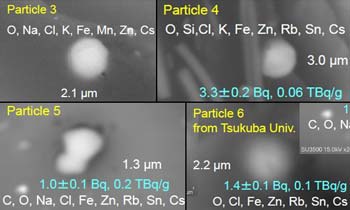http://www.asyura2.com/14/genpatu39/msg/701.html
| Tweet | �@ |

200,000,000,000,000 becquerels/kg in fuel rod materials found near Tokyo�c �gthe material spread globally�h — Composed �gmajor part�h of worst Fukushima plume — Persists for long time in living organisms — Must reconsider disaster�fs health effects (PHOTOS)
200���x�N����/ kg�̔R���_�f�ނ������̋߂��Ŕ���... �u�i�R���j�f�ނ͐��E�K�͂Ŋg�U����v�|�ň��̕����v���[�����\������u�啔���v�|�����̂ɒ����ԑ�������|�ЊQ�̌��N�ւ̉e�����čl����K�v����i�ʐ^�j
Published: August 11th, 2014 at 1:41 pm ET�@By ENENews
���J�F 2014�N8��11���A�ߌ�1:41 ET�@ ENENews�ɂ��
Presentation by Yasuhito Igarashi of Japan�fs Meteorological Research Institute at IAEA�fs expert meeting (pdf), Characteristics of Spherical Cs-Bearing Particles Collected during the Early Stage of FDNPP Accident, February 2014: [�c] We have found spherical Cs-bearing particles (Cs-ball) from HV filter samples collected during Mar. 14-15, 2011, when the first radioactive plume arrived from the FDNPP accident at the MRI [Meteorological Research Institute] as well as Univ. Tsukuba, Japan. [�c]
���{�̋C�ی������̌\���N�l�ɂ��IAEA���Ɖ�c�ł̃v���[���e�[�V�����iPDF�t�@�C���j�A������ꌴ�q�͔��d�����̂̑����Ɏ��W���ꂽ����Z�V�E���ܗL���q�̓����A2014�N2��[...]��X�͋���̃Z�V�E���ܗL���q�i�Z�V�E���E�{�[���j���A3��14〜15���Ɏ��W���ꂽHV�t�B���^�[�������甭�������B���̎��ɁA�ŏ��̕��ː��v���[�����A���{�̒}�g��w�Ɠ��l�ɁAMRI [�C�ی�����]�ɕ�����ꌴ�����̂��瓞�B�����B [...]
experiments showed that the Cs-ball occupied major part in the Mar. 14-15 Fukushima plume. They would persist for a long time in the environment as well as in living organisms. [�c] the investigation on radioactive aerosol during the second plume arrival gave no such Cs-ball. [�c] The finding should be a key to understand the processes of the FDNPP accident, to accurately evaluate the health and environmental impacts and to improve efficiency of the decontamination of the polluted area. [�c] Further studies are recommended for the present Cs-ball in more detail!
�����̓Z�V�E���E�{�[����3��14�|15���̕����v���[���ő啔�����߂Ă������Ƃ��������B�����͊��������łȂ��A���̓��Œ����ɂ킽���đ������邾�낤�B [...]���v���[���������̕��ː��G�A���]���Ɋւ��钲���́A���̂悤�ȃZ�V�E���E�{�[����F�߂Ȃ������B [...]���m�Ɍ��N����ւ̉e����]�����A�����n��̏����̌��������コ���邽�߂ɁA���̏����͕�����ꌴ�����̂̃v���Z�X�𗝉����邽�߂̌��ł���͂��ł��B [...]���݂̃Z�V�E���E�{�[���ɂ��Ă��ڍׂɁA����Ȃ錤�������������I
Particle 5: 0.2 TBq/g (200 trillion Bq/kg)
Additional research on spherical particles: Nuclear fuel found 15 miles from Tokyo suburbs — Fukushima uranium in �eglassy�f spheres transported over 170 km
���q5�F0.2 �e��Bq/ g�i200���x�N����/ kg�j
���q�Ɋւ���lj������F�j�R���͓����x�O15�}�C���i24�L�����[�g���j���甭�������|�u�K���X��v���̂̕����E������170�L�����[�g���ɂ킽���ĉ^�ꂽ

Scientific Reports (Nature Publishing Group) — Emission of spherical cesium-bearing particles from an early stage of the Fukushima nuclear accident, Aug. 30, 2013: The Fukushima nuclear accident released radioactive materials into the environment over the entire Northern Hemisphere [�c] Although the accident has global impacts, we still do not know exactly what happened in the reactors [�c] The chemical and physical properties of the radioactive materials released into the environment are not well known.
�Ȋw���|�[�g�i�l�C�`���[�E�p�u���b�V���O�E�O���[�v�j�|2013�N8��30���A�����������̂̑����i�K���狅��Z�V�E���ܗL���q�̕��o�F�����������͖̂k�����S�̂ɂ킽���Ċ����ɕ��ː���������o����[...]���̂͐��E�I�ȉe���������Ă�����̂́A��X�͂܂����q�F�ʼn����N���������𐳊m�ɒm��Ȃ�[...]�����ɕ��o���ꂽ���ː������̉��w�I����ѕ����I�����͂悭�m���Ă��Ȃ��B
Such knowledge is necessary to improve the numerical models to estimate the geographical distributions and evaluate the human exposures [...] released radioactive material [...] was spread globally [...] We collected aerosol samples [...] at the Meteorological Research Institute, Tsukuba, Japan, which is located 170 km southwest of FNPP [...] The spherical Cs-bearing particles likely have longer retention times on the land surface than those of the water-soluble Cs particles. The retention time of the particles in the soil or other environments needs to be reconsidered. The health effects of the particles should be evaluated [...]
���̂悤�Ȓm���́A�n���I���z�𐄒肵�l�Ԃ̔��I��]�����鐔�l���f�������P���邽�߂ɕK�v�ł���B���o���ꂽ���ː�������[...]���E�I�ɍL������[...]������ꌴ����170�L���쐼�Ɉʒu����A���Ύs�̋C�ی������ɂ����� [...]��X�̓G�A���]���i�����́j�̃T���v�������W����[...] [...]����Z�V�E���ܗL���q�́A���n���Z�V�E���̗��q�ɔ�ׂāA�n�\�ʏ�ł͂�蒷�����ԑ��݂���\���������B�y��܂��͑��̊����ɂ����闱�q�̑ؗ����Ԃ͍čl����K�v������B���q�̌��N�ւ̉e����]�����ׂ��ł���[...]

See also: See also: Gundersen: This video �gconfirms our worst fears�h — Scientist: Reactor core materials found almost 500 km from Fukushima plant — 40,000,000,000,000,000,000 Bq/kg — Can travel very, very significant distances
�Q�ƁF�Q�ƁF�K���_�[�Z���F���̉f���́u�������̍ň��̋��|���m�F����v--�Ȋw�ҁF�F�S�R���͕������q�͔��d������ق�500�L�����[�g���i���É��j�Ŕ������ꂽ--40,000,000,000,000,000,000�i�S�狞�j�x�N����/kg --���ɁA���ɉ��������ړ����邱�Ƃ��ł���--�z�b�g�E�p�[�e�B�N���͓����ƕ�������̎�����25 ���ɔF�߂��i�f���j
�@
������@�@�@�@�@ �����C���� > �����E�t�b�f39�f�����@���� �@�O��
 �X�p�����[���̒����猩���o�����߂Ƀ��[���̃^�C�g���ɂ͕K���u���C������ցv�ƋL�q���Ă��������B
�X�p�����[���̒����猩���o�����߂Ƀ��[���̃^�C�g���ɂ͕K���u���C������ցv�ƋL�q���Ă��������B���ׂẴy�[�W�����p�A�]�ځA�����N���������܂��B�m�F���[���͕s�v�ł��B���p�������N��\�����Ă��������B